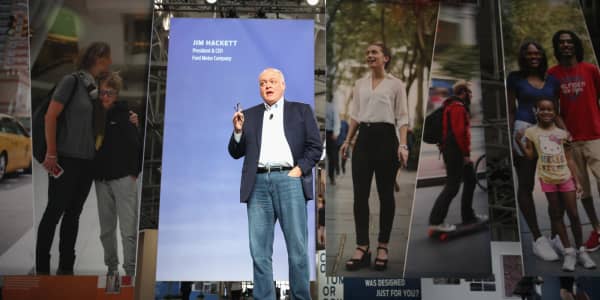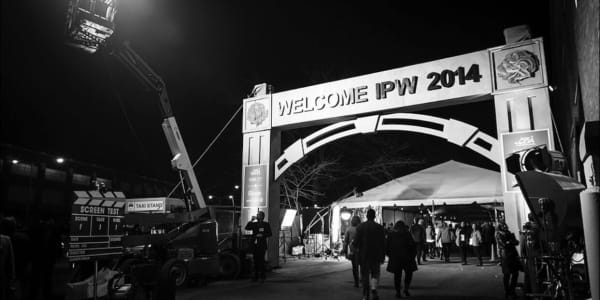And the Oscar for biggest studio blunder goes to ...
Ever since the original "Star Wars" came along in 1977, every major movie studio has hoped that their next movie is the first in a successful franchise. And today studios want to know that the property they're green-lighting is good for sequels, toys, T-shirts, Happy Meals and whatever else it can be milked for.
The Marvel Cinematic Universe is a good example of what they're looking for. This franchise has thus far produced 12 movies, including "Avengers: Age of Ultron" and "Iron Man." All together, the movies have made a combined $9 billion worldwide, according to Box Office Mojo, a number that you can expect to go up when "Captain America: Civil War" is released on May 6.
There's just one problem with planning a movie franchise ahead of time. No matter how iconic the property is, and no matter how many high-fives a studio head gets upon buying the movie rights to it, you can't make audiences show up. CNBC.com presents 10 movies with franchise-starting potential, and which didn't survive their collisions with reality. Learn the lessons they didn't learn in time.
— By Dan Bukszpan, special to CNBC.com
Posted 23 April 2016
"Battleship" (2012)
"Battleship" is a Milton Bradley board game that families have been playing since 1967, so with that kind of brand recognition, it's understandable why a studio head would believe that it would inspire blockbuster ticket sales. Unfortunately, the $209 million movie opened in May 2012 to a dismal $26 million at the domestic box office and received a critical drubbing.
In addition to the pitiful box-office revenue, there was a failed video game of the same name released concurrently, whose purpose was to ride the movie's assumed runaway success. Apparently, just because rival studio Paramount was able to make a worldwide box-office gross of $3.8 billion on its "Transformers" franchise, it doesn't necessarily follow that your studio's movie based on a toy or a game will do the same.
"Thunderbirds" (2004)
"Thunderbirds" was a British science-fiction television show that aired in the 1960s and used marionettes. If that description doesn't jog your memory, nothing will, which makes pertinent the question: "Why was this turned into a live-action movie of the same name in 2004?"
It cost $57 million to make, and it earned $28 million at the worldwide box office, a failure by any standard. It was also critically savaged, and the one-and-a-half-star review by the late Roger Ebert explained exactly why the movie flopped.
"This is a movie made for an audience that does not exist, at least in the land of North American multiplexes: fans of a British TV puppet show that ran from 1964 to 1966," he wrote. So if you have an idea for a franchise, make sure the consumer base for it is not imaginary, and know your geography.
"The Lone Ranger" (2013)
Few American properties are as iconic as the Lone Ranger. Nonetheless, bringing him to the big screen has proved challenging. There was an attempt to do so in 1981 with "The Legend of the Lone Ranger," which was so spectacular a commercial and critical failure that the lead actor, Klinton Spilsbury, never made another movie. Thirty-two years later Hollywood gave it another go, this time casting Johnny Depp and hiring director Gore Verbinski, best known for directing the first three films of the "Pirates of the Caribbean" saga.
Walt Disney Studios threw a $250 million production budget and a $150 million advertising budget at it, necessitating a box-office take of $800 million to break even. A high bar to clear, to be sure, but just prior to its release, producer Jerry Bruckheimer compared it to the successful Marvel franchises. "You see all of these wonderful Marvel characters that have been around forever, and the Lone Ranger has been around forever and fights evil, too," he told Variety. "Audiences like that."
When it was released, it earned a worldwide gross of $261 million, more than $500 million shy of recouping its costs. But it's not fair to blame the movie's box-office failure on the unhappy track record that Hollywood has had with the character. Rather, recent Hollywood history is littered with the corpses of big-budget westerns that did miserably at the box office, such as "Cowboys and Aliens" and "The Alamo," suggesting that the demand was never there to begin with.
"John Carter" (2012)
"John Carter" is one of the biggest flops in cinema history. A science-fiction movie produced by Walt Disney Pictures, it cost a reported $350 million and was intended to be a franchise that went beyond mere sequels and would include theme-park attractions and all manner of merchandise. The problem was that it had to earn $600 million worldwide just to break even, and it came nowhere close.
"The studios are just spending too much money, and there's just not the box office there to support it," said Paul Dergarabedian, president of the pop-culture website Hollywood.com. This is a good lesson for anyone considering any kind of franchise. Keep your costs under control or else you'll find yourself in a hole that only a record-breaking consumer response can dig you out of, and that's not something you can count on.
"Ender's Game" (2013)
Author Orson Scott Card's "Ender's Game" series of science-fiction books was a natural choice for franchise material, consisting as it did of 15 very popular novels, numerous short stories and multiple comics. The movie "Ender's Game" was released in 2013 and earned $126 million at the worldwide box office, just barely recouping its $110 million production budget. That wasn't enough to justify a single sequel, much less an entire franchise, even though plans for both a sequel and a television show were already on the table.
So what went wrong? Card, a Mormon, had been a vocal opponent of homosexuality for decades, and a boycott of the movie inspired by the organization Geeks OUT dampened enthusiasm for it. In the future, aspiring film franchisers are advised to do their due diligence when researching source material, particularly when it's written by someone about whom a single Google search will reveal more than 20 years of openly antihomosexual views in writing and who had just five years earlier written that legal recognition of gay marriage would herald the end of democracy in America.
"The Green Lantern" (2011)
"The Green Lantern" was based on the DC Comics character, portrayed by Ryan Reynolds of "Deadpool" fame. It had a $200 million production budget, a $100 million domestic advertising budget and product tie-ins that included two roller coasters — one at Six Flags Great Adventure in New Jersey, and the other at Six Flags Magic Mountain in California — and a sequel already green-lit a full year before the first movie had even come out. It had all the makings of a great franchise, but sadly, audiences didn't show up, resulting in worldwide gross earnings of just $220 million.
The reviews certainly didn't help. Christy Lemire of The Associated Press called the movie "joyless," comparing it to "'Top Gun' with magical jewelry." The lesson here is simple: Don't plan your expansion before consumers demonstrate they like your product. However, this lesson has not been internalized — the franchise is scheduled to be rebooted in 2020.
"Fantastic Four" (2015)
"The Fantastic Four" is a superhero comic that has been the subject of numerous adaptations, including two movies, in 2005 and 2007. A 2015 reboot was directed by Josh Trank and had a production budget of $120 million, but it made only $56 million at the domestic box office. The bad reviews were only part of the problem. During production Trank had clashed with the studio, 20th Century Fox, and he took to Twitter just prior to the opening to vent about it.
"A year ago I had a fantastic version of this," he wrote. "And it would've received great reviews. You'll probably never see it. That's reality though." It's hard to quantify the effect this outburst had on the movie's bottom line, if any, but it couldn't have helped.
In November 2015 a sequel scheduled for 2017 was pulled from the studio's production schedule, effectively killing the franchise and demonstrating the importance of messaging discipline to the franchisers of tomorrow.
"Jonah Hex" (2010)
"Jonah Hex" is a DC Comics character with a scarred face that you wouldn't want to look at for 81 minutes. Warner Bros. Pictures felt otherwise and cast actor Josh Brolin to portray the disfigured western bounty hunter in its 2010 film adaptation. A year prior to the movie's release, there was already talk of casting for the hypothetical sequels that the movie might inspire if it were a success. It wasn't.
The production budget for "Jonah Hex" was $47 million, and it barely eked out a worldwide box-office gross of $11 million. It couldn't have helped that it was released on the same day as "Toy Story 3," the 18th highest-grossing movie of all time, but even if that hadn't been a factor, the uniformly negative reviews guaranteed its failure at the box office.
If there's a lesson to be learned, it would be to make sure that the property you want to turn into a franchise actually has the mainstream potential to justify it.
"The Incredible Hulk" (2003)
Universal Pictures' "Hulk" was a 2003 depiction of the green, rage-based comic superhero. Its budget was $137 million, and it made a respectable $245 million at the worldwide box office, so franchise potential certainly existed. However, Marvel Studios reacquired the rights to the character and rebooted the franchise with "The Incredible Hulk" in 2008. The movie earned $263 million at the worldwide box office after the studio spent $150 million on the production, an almost identical reception to its predecessor.
The creature has since appeared in the past two "Avengers" movies but has yet to be the subject of its own standalone franchise, a la "Thor." According to star Mark Ruffalo, the Hulk is still a Universal property, not a Marvel property and is "not any closer" to getting his own movie, let alone his own franchise. The lesson here is that if you want to build a franchise, make sure you have exclusive rights to the property.
"The Man from U.N.C.L.E." (2015)
People of a certain age will remember the 1960s NBC television series "The Man from U.N.C.L.E.," which starred Robert Vaughn as an international spy. It was made into a movie in 2015 starring Henry Cavill of "Batman vs. Superman: Dawn of Justice" fame. It had a reasonable-for-2015 $75 million budget and earned $110 million at the worldwide box office, all while earning decent reviews. So with that kind of profile, a franchise is justifiable, right?
Not necessarily. The jury is out on whether or not the movie will even get a single sequel, although Cavill said that he would be up for it. But sequels and franchise plans are often in place well in advance of a movie's release date, so it may be that the lack of franchise chatter doesn't bode well for this particular property, despite its warm reception.
The lesson to be extrapolated in this case may be that just because you've earned a franchise, it doesn't necessarily mean that you'll get one.




